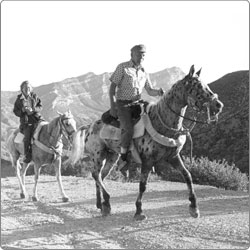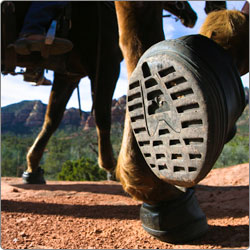A History of Hoof Boots
 Hoof boots have provided protection and comfort to horses for more than forty years. Boots are used worldwide over bare hooves and shod hooves alike, whether as a therapy for horses in pain, as protection from the hazards of wilderness trail or simply as a spare tire for a lost steel shoe.
Hoof boots have provided protection and comfort to horses for more than forty years. Boots are used worldwide over bare hooves and shod hooves alike, whether as a therapy for horses in pain, as protection from the hazards of wilderness trail or simply as a spare tire for a lost steel shoe.
Hoof boots have benefitted from tremendous technological advancements in both material and design over the last six years. Today's hoof boots provide a dependable solution to hoof protection. They are easy to put on and remove and they weigh less than steel shoes.
A History of Hoof Boots | Timeline
-
1969

Dr. Neel Glass, a nuclear physicist at the Los Alamos Scientific Laboratory in New Mexico, bought a horse for his two young daughters. The horse soon began to show occasional lameness and was diagnosed as having navicular disease.
At the advice of a veterinarian his farrier installed iron shoes with built-up heels on the front feet, but it didn't solve the problem. When winter brought the first snow, it accumulated under the hooves, impairing the horse's gait and movement even more.
Dr. Glass searched for a suitable boot with an enclosed bottom that could be slipped over the hooves so snowballs would not accumulate. When he found nothing available, he became interested in the age-old problem of hoof protection, traction and treatment. He began to improvise.
-
1970

Dr. Glass had made many prototypes with patent possibilities and decided to form a company to manufacture and market a horse boot.
-
1971

The Easyboot name had been trademarked and boots were selling well. Dr. Glass resigned his position at the laboratory, continuing as a consultant there. He devoted his time exclusively to the development of Easyboot. He completed a course in horseshoeing at the Agricultural College of New Mexico State University and became a charter member of the American Farrier's Association.
The first major practical test of Easyboot came when he got a call from a horseman who was riding from Florida to Arizona and was having trouble with iron shoes because of the nail holes in the hooves. The iron shoes were wearing out in 250 miles or less. Dr. Glass sent him Easyboots which he used all the way to Arizona with no more problems.
-
1973

Dr. Glass conducted his own test of Easyboots in endurance riding. Other riders were beginning to use Easyboots as "spare tires" in such rides. He decided to use them throughout an entire 250-mile five-day race. He tied for fifth place in the first Los Alamos Endurance Ride.
Over the next several years he and his wife, Lucille, each rode more than 5,000 miles in American Endurance Ride Conference sanctioned rides. All of the miles completed by Dr. Glass and Lucille were with Easyboots over bare hooves. Easyboots proved their worth in these events.
-
1975

Neel Glass completes the 100-Mile Tevis Cup in unaltered Easyboots.
-
1979

The British Post office sponsored The Pony Express Race to publicize a commemorative stamp issue honoring Sir Rowland Hill, the inventor of the adhesive postage stamp. The race was held over the historic Pony Express Trail between St. Joseph, Missouri and Sacramento, California, a distance of some 2,000 miles.
Riders raced about 60 miles per day and each segment was a separate race. Each rider had four horses. Glass entered the race and by the midpoint was near the rear of the pack. Wearing Easyboots, his horses seemed to do better and better and began to win the daily races. Other riders began to switch to Easyboots and by the end of the race, Glass was in second place and every rider was using Easyboots.
Over the years, Easyboots have become more and more popular. Equestrians with a wide spectrum of applications have benefited from the evolution of the Easyboot.
-
1998

David MacDonald invents the Original Old Mac's multi-purpose hoof boot, specifically catered to the trail and backcountry rider. David also ventured into keeping his horses barefoot. "Back then, people laughed at me when I said horses can effectively work barefooted if their hooves were properly shaped and maintained and if protective boots are used."
-
2004

Jaime Jackson's group of AANHCP group of volunteers tests the Boa Horse Boot. The group included Pete Ramey, Kirt Lander, Becky Goumez, Steve Fournier, Paige Poss, Michelle Sarruf, Jon Thomas and Cindy Sullivan.
-
2005

Granite Chief wins the AERC National Mileage Championship, accumulating an impressive 2,245 competition miles in Easyboot Epics.
The AANHCP group of volunteers tests the Easyboot Epic.
The Easyboot Epic was introduced. Derived from the Original Easyboot, the Epic enjoyed the protective qualities of the original boot with the additional security of a gaiter to keep the boot in place and to protect the pastern from dirt and debris.
The Old Mac's Generation 2 (G2) boot is released as an updated version of its predecessor. Also used help aid in recovery from concussion injuries, this boot incorporates the Hoof Suspension™ system.
-
2006

Easyboot Bare is introduced to provide a simple, close-fitting boot that flexes with hoof movement.
Easyboot Epic is named The Horse Journal's Product of the Year.
-
2009

The Easyboot Glove is introduced and will quickly become the best selling boot in the world. Sporting a new aggressive tread, the boot is void of hardware like clips and buckles and is designed to be easily applied to a barefoot hoof. It provides dependable, long-lasting hoof protection over any terrain.
Easyboot Edge introduced with a new fastening system, a padded tongue and a new aggressive tread pattern that would lead to the design of the new Easyboot Glove.
The Easyboot RX is launched to accommodate horses requiring a therapy boot. The new boot is immediately embraced by vets, hoof care professionals, and horse owners requiring relief from chronic lameness, founder, laminitis, navicular and bruising.
-
2010

A barefoot/booted horse makes history: The Fury wins the coveted Haggin Cup for Best conditioned horse wearing Easyboot Glue-Ons over barefoot hooves at the Tevis 100 Mile race.
This is the first time in 54 years of Haggin Cup presentations that a barefoot/booted horse wins the cup. A staggering 30% of the horses in the top 20 at the 2010 Tevis were barefoot/booted.
The significance of this achievement cannot be overstated. The Tevis Cup 100 Mile race is regarded as not only one of the most challenging horse races in the world, but was recently listed in Time Magazine's Top Ten Endurance Competitions, alongside epic events like the Iditarod, the Dakar Rally, and 24 Hours of LeMans.
-
2011

The Easyboot Trail was launched in April, 2011.
The Easyboot Trail hoof boot is the latest offering for barefoot horses from the EasyCare. The Easyboot trail is designed with value and ease of use in mind. After listening carefully to the wants and needs of customers through surveys, conversations and extensive testing, EasyCare is convinced they have created the easiest hoof boot in the world.
This hoof boot is designed to allow for up to eight weeks of hoof growth for most horse, creating a much more forgiving fit. The boot is recommended for middle distance riding - with the general guideline listed as up to 25 miles per week (usually an average of 1 - 1 1/2 hours a day). This makes the boot a top choice for leisure riders. The Easyboot Trail's simple closure system makes it very easy to use simple hoof boot to use, with no force required to apply or remove it.
-
2013

The Easyboot Transition was launched in November, 2013.
The Easyboot Transition was launched in November 2013 and offers an innovative combination of shock absorption and support never before seen in a hoof boot. The Easyboot Transition is available in eight sizes that accommodate many hoof shapes and angles. This is an ideal hoof boot for pleasure riding (less than 25 miles per week) and is also suitable for therapeutic applications.
Leather and soft-weave fabric is lightweight yet durable to protect the hoof from rocks, roots and other trail hazards. A seamless mold between the upper and bumper eliminates the need for stitching. Industrial strength hook and loop straps secure the boot on the hoof and allow for multiple adjustments. A robust bumper adds flexibility to the core of the boot while a supportive midsole increases shock absorption. Fabric and synthetic materials resist wear and increase stability beneath the midsole.